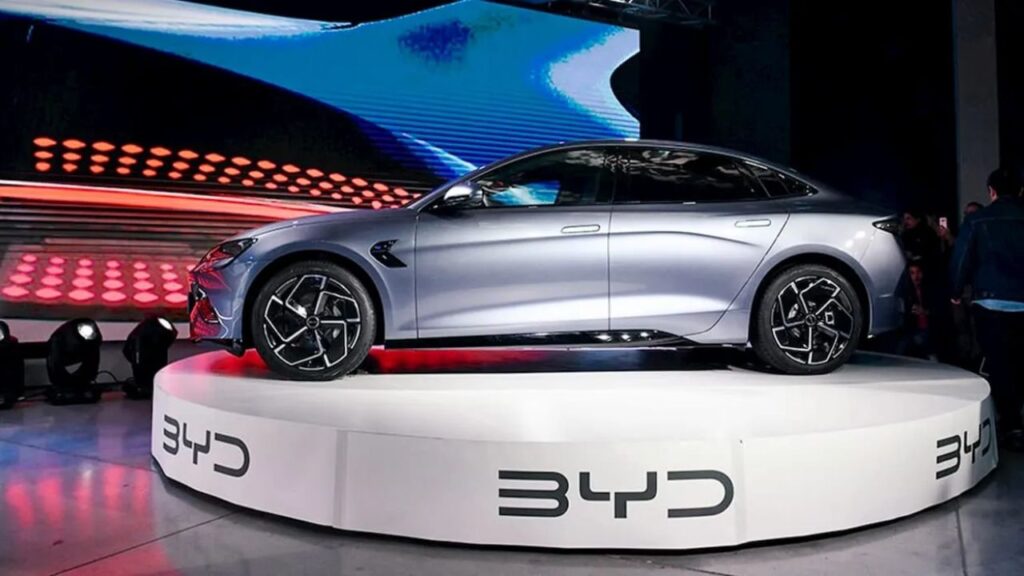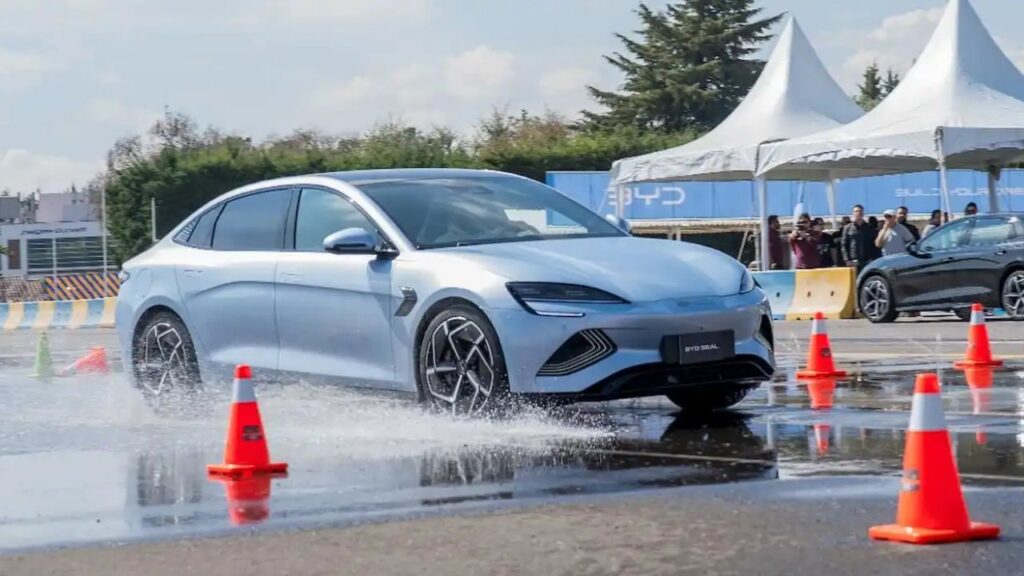The Australian electric vehicle landscape just witnessed a massive power shift that nobody saw coming this dramatically. BYD has officially crossed the 40,000 sales milestone in Australia, achieving in less than three years what took Tesla a decade to accomplish. Meanwhile, Tesla’s grip on the market is loosening faster than anyone predicted.
This isn’t just another sales story – it’s a complete transformation of Australia’s EV market dynamics. The Chinese automotive giant is making moves that would make even the most seasoned car industry veterans take notice.
BYD’s Lightning-Fast Rise to 40,000 Sales

Here’s what makes this achievement so impressive: BYD reached 40,000 sales in less than three years, while Tesla took about 10 years to hit the same milestone. That’s not just fast growth – that’s explosive market penetration.
The company hit this milestone following a record-breaking February 2025 with 3,281 units sold, headlined by the first deliveries of the Shark 6 PHEV. But here’s where things get really interesting: BYD isn’t slowing down.
The numbers tell a compelling story. BYD’s Australian sales totalled 20,458 in 2024, representing a 64.5% increase over 2023 figures. Their lineup includes heavy hitters like the Seal EV sedan (6,393 sales), Sealion 6 PHEV (6,198), and the ever-popular Atto 3 compact SUV (5,751).
What’s Driving BYD’s Success?
The secret sauce isn’t just one thing – it’s a perfect storm of smart positioning:
- Aggressive pricing strategy with the Dolphin Essential breaking the $30,000 barrier at $29,990
- Diverse model range covering everything from compact cars to plug-in hybrid utes
- Strategic timing with PHEV launches during peak demand
- Local partnership with EVDirect proving highly effective
Tesla’s Stunning Sales Collapse
While BYD celebrates, Tesla faces its worst performance in years. Tesla delivered 38,347 vehicles in Australia during 2024, representing a 16.9% drop from its 2023 performance. But 2025? That’s where things get really dramatic.
Tesla’s first two months of 2025 saw sales plummet 66% to just 2,331 from 6,772 in the same period of 2024. We’re talking about a company that once dominated two-thirds of Australia’s EV market now struggling to maintain relevance.
The Model Y Meltdown
The Model Y, traditionally Tesla’s volume seller, saw deliveries fall by 26.1% in 2024 to 21,253 examples. Even more concerning? Model Y sales dropped to just 924 units in February 2025, down from 2,072 in February 2024.
The Model 3 isn’t faring much better. February 2025 saw an 81.4% crash in Model 3 sales to just 668 units, down from 3,593 in February 2024.
2025 Projections: The Year Everything Changes
Industry experts are calling 2025 the year of transition for Australia’s EV market. Experts predict EVs will capture 11% of all new car sales in 2025, equating to around 130,000 vehicles.
BYD is targeting over 40,000 sales in 2025 alone – matching their entire three-year cumulative achievement in just one year. That’s ambitious, but considering their current trajectory, it looks achievable.
BYD’s 2025 Ammunition
The Chinese brand isn’t just hoping for growth – they’re engineering it:
- Shark 6 PHEV already becoming Australia’s third best-selling utility vehicle
- Sealion 7 taking monthly EV sales leadership with 743 units in April 2025
- Expanded model range with potential seven-seat SUV and compact options
- Factory-backed Denza luxury brand launching without EVDirect involvement
Market Dynamics Reshaping Australia’s EV Landscape
Tesla’s market share has crashed from over 50% late last year to just 8% in recent months. This isn’t just competition – it’s a fundamental market restructuring.
Chinese brands are dominating. Eight of the 10 best-selling EVs in Australia’s first quarter 2025 were Chinese-made vehicles. That statistic alone shows how dramatically the landscape has shifted.
Why Tesla Is Struggling
Multiple factors are hammering Tesla’s Australian performance:
- Increased competition from well-priced Chinese alternatives
- Model fatigue with aging designs lacking updates
- Political backlash against CEO Elon Musk’s controversial statements
- Supply chain issues affecting Model Y refresh timing
The PHEV Factor: BYD’s Secret Weapon
One area where BYD absolutely demolishes the competition is plug-in hybrids. The BYD Shark 6 ute made up 1,293 of the 2,601 PHEVs sold in April 2025 – that’s nearly 50% market share in one month.
This hybrid strategy brilliantly addresses Australian consumers’ range anxiety while providing fuel savings. Tesla’s pure-EV approach suddenly looks limiting by comparison.
Infrastructure Reality Check
Australia’s charging infrastructure still has gaps, making PHEVs an attractive compromise. BYD recognized this market reality while Tesla stubbornly stuck to battery-only solutions.
What This Means for Australian Car Buyers
The BYD surge creates unprecedented choice for EV shoppers. Budget-conscious buyers now have compelling options like the BYD Dolphin, offering quality without premium pricing.
Competition is driving innovation across the board. Tesla’s upcoming Model Y refresh and rumored Model Q compact SUV show they’re fighting back, but BYD has momentum.
Price Wars Benefit Everyone
More competition means better deals. BYD’s aggressive pricing forces everyone to sharpen their pencils, creating genuine value for Australian consumers.
Can Tesla Recover?

The facelifted Tesla Model Y ‘Juniper’ launches in April 2025, potentially providing salvation for Tesla’s struggling sales. But will updated styling be enough to counter BYD’s value proposition?
Tesla still has advantages:
- Supercharger network remains superior
- Brand recognition stays strong despite recent struggles
- Over-the-air updates provide ongoing value
- Performance credentials in premium segments
The Verdict for 2025
BYD’s targeting 40,000+ sales while Tesla fights to stabilize. The Chinese brand reached 40,000 cumulative sales far quicker than Tesla, which took about 10 years – and they’re just getting started.
This isn’t just about two brands anymore. Australia’s EV market is becoming genuinely competitive, with Chinese manufacturers proving they can deliver quality, value, and innovation simultaneously.
Bottom line? BYD’s 40,000-unit milestone represents more than sales success – it’s evidence that Australia’s EV monopoly era is definitively over. Tesla’s declining dominance creates space for brands like BYD to flourish, ultimately benefiting Australian consumers through better choice, pricing, and innovation.
The revolution is here, and it’s speaking Mandarin.
Short FAQs
Q: How long did it take BYD to reach 40,000 sales in Australia?
Less than three years since relaunching with EVDirect in 2022.
Q: What’s Tesla’s biggest challenge in Australia right now?
Declining sales across both Model Y and Model 3, with 2025 showing 66% drops.
Q: Which BYD model is selling best?
The Sealion 7 currently leads monthly sales, while the Seal was 2024’s top performer.
Q: Is the BYD Shark 6 really that popular?
Yes, it captured nearly 50% of Australia’s PHEV market in April 2025.
Q: What’s driving BYD’s success over Tesla?
Competitive pricing, diverse model range, PHEV options, and strategic local partnerships.
Q: Can Tesla recover its market position?
The updated Model Y Juniper and potential Model Q could help, but BYD has strong momentum.

